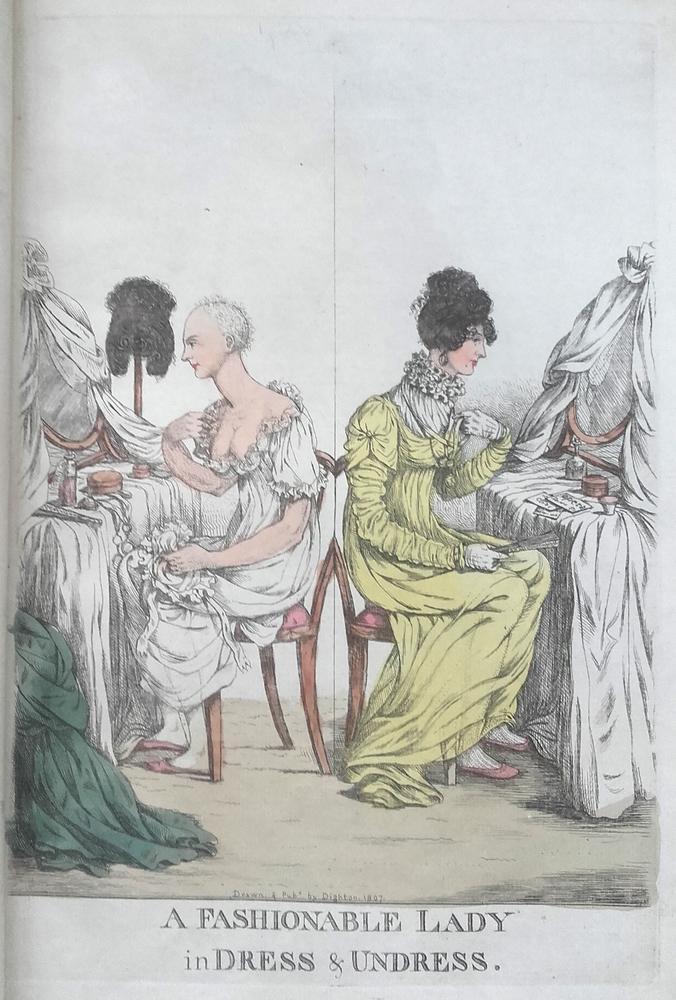Context:
In the time of political and social revolutions in the west, fashion was also undergoing its own revolutions. Gone were the frivolous and ornate fashions of the baroque and rococo styles; in was the seemingly simple and toned down regency style. Women’s clothing from 1790-1820 favored high waistlines and long skirts made of light fabrics such as muslin and gauze. Most scholars agree that the simplification and focus on comfort and movement reflects the growth of the push for greater rights for women during this time. The simple, graceful lines of the clothing were also inspired by ancient Greek and Roman statuary, reflecting the rise of the neoclassical (Boucher and Deslandres 346). French fashion also remained a big influence on British fashion, especially the fashion of Josephine, Napoleon’s wife and Empress from 1804-1810 (Cosgrave 189,205). Unmarried women often wore white and pastels with simple accessories. Married women wore somewhat stronger colors and often wore more accessories (Brown 173). Corsets were considerably less structured as well. While they provided structure and support, they became shorter and less restrictive. From about 1790-1805, most corsets did not even include boning (whalebone or other stiff material to provide support) (Boucher 347). Women’s hair was also worn in shorter styles. Wigs had been quite popular among high class women in the time before the Romantic era. During the Romantic era, wigs were less commonly worn than in the past, but many wealthy women still wore them for the sake of ease (Amphlett 131).
A Fashionable Lady in Dress & Undress:
The above image is a satirical print from 1807 which depicts a seemingly wealthy and fashionable woman before and after she gets dressed. In the first image, she wears a simple shift and is stripped of all ornaments and accessories, even her hair. This is a sharp contrast to the second image where she sits in her fine clothing and accessories, covered from head to foot. This contrast is certainly intentional and has some interesting implications. It highlights a sense of artificiality about the woman’s appearance. The woman’s final look does not reflect how this woman truly looks. Not only is the woman’s appearance artificial, but the clothing feels so too. The fashions of the time championed simplicity, yet look at how much work and clothing must go into this woman’s look. Perhaps this image is just a joke about the ridiculous nature of fashion, but it could also mean so much more. As mentioned before, the fashions of the day reflected the social and political changes of this time such as the renewed interest in the Classical and the spread of revolutionary ideas. In this case, the modern, fashionable woman in the picture is a symbol for British society. It champions revolutionary ideas, but these are all artificial ornaments. Like the clothing this woman wears, these ideas will soon fall out of fashion, so why go into all this trouble to parade them around?
Sources:
Amphlett, Hilda. Hats: A History of Fashion in Headwear. Dover Publications, 2003.
Boucher, François, and Yvonne Deslandres. 20.000 Years of Fashion the History of Costume and Personal Adornment. Harry N. Abrams, 1987.
Brown, Susan. Fashion: The Definitive History of Costume and Style. DK Publishing, 2012.
Cosgrave, Bronwyn. The Complete History of Costume & Fashion: From Ancient Egypt to the Present Day. Checkmark Books, 2001.


